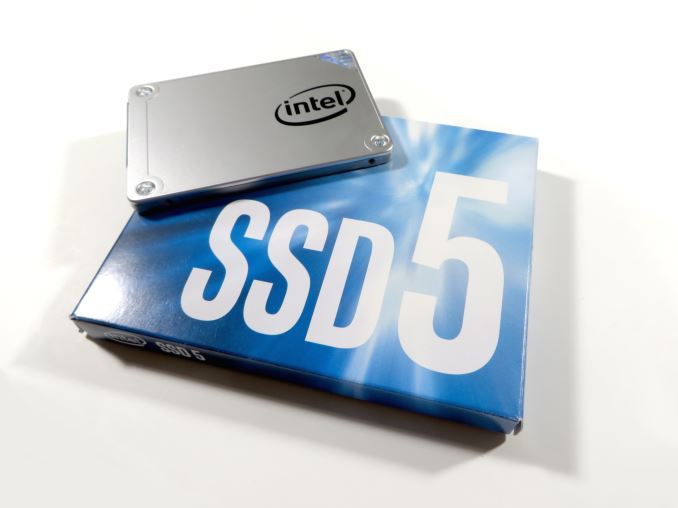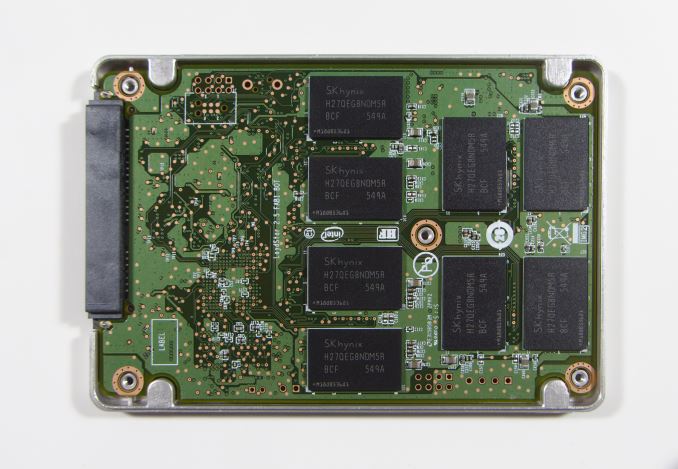The Intel SSD 540s (480GB) Review
by Billy Tallis on June 23, 2016 9:00 AM EST
Every few years, Intel releases a new SSD controller that raises the bar for the whole industry. In between those shake-ups, the competition catches up and surpasses Intel. This pattern is especially pronounced in the consumer SSD market where Intel's mostly enterprise-focused chips cannot keep pace with the constant price cuts. During those interim years Intel turns to third-party controllers to fill the gaps in the product line that their own controllers cannot serve.
This year, Intel's decision to release an affordable mainstream SATA SSD has led them to use a Silicon Motion controller. But "affordable" by today's standards means using 15/16nm TLC NAND flash, and Intel doesn't make that either. They chose not to invest in the 16nm node at IMFT (their flash manufacturing partnership with Micron) so Intel has to buy their flash on the open market.
The result is the Intel 540s, using Silicon Motion's new SM2258 controller and SK Hynix 16nm TLC NAND. The SM2258 controller is the successor to the SM2256, Silicon Motion's first controller designed for use with TLC flash. SM2258 builds on that design by moving from 55nm fabrication to 40nm and incorporating several hardware tweaks including more flexible SLC caching and support for 3D NAND.
The Hynix TLC used in the Intel 540s is the same NAND that is inside the ADATA Premier SP550, one of two products we've tested that use the SM2256 controller. This gives us the opportunity to directly observe what's improved with Silicon Motion's controller and firmware since last year. The price history of the ADATA SP550 also shows that Intel should be able to make the 540s a very affordable product. It also appears that Intel has retired the use of 3xx model numbers to designate entry-level SSDs and all such models are now classified as legacy products.
| Intel SSD 540s Specifications | ||||||
| Capacity | 120GB | 180GB | 240GB | 360GB | 480GB | 1000GB |
| Controller | Silicon Motion SM2258 | |||||
| NAND Flash | SK Hynix 16nm TLC | |||||
| Sequential Read | 560MB/s | |||||
| Sequential Write | 400MB/s | 475MB/s | 480MB/s | |||
| Random Read IOPS | 60k | 71k | 74k | 78k | ||
| Random Write IOPS | 50k | 85k | ||||
| TCG Opal Encryption | No | |||||
| Power Management | Slumber and DevSleep | |||||
| Form Factor | 2.5" 7mm and M.2 2280 | |||||
| Warranty | 5 years | |||||
| Recommended Customer Price | $64 | $79 | $99 | $139 | $174 | $344 |
The 540s has Intel's typical aluminum casing housing a full-size PCB. Our 480GB sample had 16 packages each with two dies of the SK Hynix TLC. The new SM2258 controller uses the same 14mm x 14mm package as the SM2256, with a single external DRAM package next to it. As is typical for low-cost consumer drives, there are no power loss protection capacitors. There is a thermal pad between the controller and the case, something we saw for the SM2256 on the Crucial BX200 but not the ADATA SP550.
The PCB also bears the "Loyd Star" codename which the 540s shares with Intel's SSD E 5400s for the embedded market and the SSD DC S3100 for the enterprise market. The E 5400s covers only small capacities, ranging from 48GB to 180GB while the 540s is available in capacities from 120GB to 1000GB and the DC S3100 covers 180GB to 1000GB. All three product lines include some in-between sizes that are uncommon to find on modern drives. The 540s and E5400s are both available as 2.5" or M.2 drives while the DC S3100 is only available as a 2.5" drive.
For this review, the Intel 540s will primarily be compared against the two SM2256 products we've tested: the ADATA Premier SP550 and the Crucial BX200. The latter shipped with poorly-tuned firmware that made it a disappointment all around, but the former has been a relatively successful budget drive by offering acceptable performance at some of the best prices on the market. The Intel 540s is positioned slightly higher in the market due to carrying a 5-year warranty compared to three years for most budget TLC drives, but in terms of performance that's what it is competing against.
Other important drives to compare against will include the Toshiba OCZ Trion 150, a higher-performing drive using a controller based on the Phison S10 paired with Toshiba 15nm TLC, and the SanDisk X400 using Marvell's 88SS1074 controller and SanDisk's 15nm TLC. The SanDisk X400 seems to be the fastest planar TLC drive on the market, and it is available in both 2.5" and single-sided M.2 form factors. The SanDisk X400 also has a 5-year warranty.
| AnandTech 2015 SSD Test System | |
| CPU | Intel Core i7-4770K running at 3.5GHz (Turbo & EIST enabled, C-states disabled) |
| Motherboard | ASUS Z97 Pro (BIOS 2701) |
| Chipset | Intel Z97 |
| Memory | Corsair Vengeance DDR3-1866 2x8GB (9-10-9-27 2T) |
| Graphics | Intel HD Graphics 4600 |
| Desktop Resolution | 1920 x 1200 |
| OS | Windows 8.1 x64 |
- Thanks to Intel for the Core i7-4770K CPU
- Thanks to ASUS for the Z97 Deluxe motherboard
- Thanks to Corsair for the Vengeance 16GB DDR3-1866 DRAM kit, RM750 power supply, Carbide 200R case, and Hydro H60 CPU cooler












77 Comments
View All Comments
Drasca - Tuesday, June 28, 2016 - link
There is a matter of scale. What is efficient for the small scale is not efficient for the large scale deployment.> even though it would probably save them a lot of dough
It wouldn't, it'd create the opposite effect costing them far more in the long run. You're thinking from the personal perspective where maintenence, reliability and security isn't an issue and non critical.
En mass, it costs them far more to have downtime, maintaining and replacing gear, than it does the initial purchase-- security notwithstanding either. They have to pay people time and money to keep the equipment up, whose price just snowballs as downtime accrues. The initial equipment cost is extremely fractional compared to the human resource cost of dealing with the equipment afterward, keeping track of it, security, physically replacing as it goes down, etc.
Buying from bulk also guarantees Hp/dell/lenovo has standardized problems and they replace the gear as it breaks wholesale. The equipment is closer to leased than purchased, with basically extended warranty guarantees. Consumer equipment does not have these protections and guarantees.
It costs far far far more in human resources spending time and money upkeeping a lot of gear that breaks, and all things will eventually break with this many pieces of equipment, taking up space that costs even more money, and causing a clusterfuck when you don't have government contracts.
The consumer level does not work at the government level and vice versa.
>entirely new workstation for that user.
They actually get entirely new workstations, for the most part. . . and old ones are worked to hell until budgets come in and approved for for upgrades across the board.
woggs - Thursday, June 23, 2016 - link
Intel doesn't ship unreliable drives (and will fix an issue if it slips out). That's the one thing you get from intel and is why they can get the big OEM orders. Other than that, I agree with "meh."trparky - Thursday, June 23, 2016 - link
For Christ's sake, why are we still using Planar NAND? Haven't we learned already that Flash memory at anything smaller than 19nm is just too unreliable? For God's sake! Everyone should be moving to 3D NAND already!trparky - Thursday, June 23, 2016 - link
Unless it's using 3D NAND, I won't buy it.ClockHound - Thursday, June 23, 2016 - link
3D? If it's not 4D, I'm not putting precious historically disposable data on it.chrcoluk - Sunday, July 17, 2016 - link
looks like its planar I am guessing by the small manufacturing size, one of the reasons ofr 3d nand is to use larger manufacturing process which has more reliable flash.16nm TLC is too scary for me.
euskalzabe - Friday, June 24, 2016 - link
Agreed. I was on the verge of buying a 512GB X400 but I think I'll wait until the fall, see what 3d NAND comes out...maxxbot - Thursday, June 23, 2016 - link
Who is this marketed for exactly? The X400 is faster AND cheaper, the 850 EVO is around the same price and much, much faster. It looks like you didn't even read the review.maxxbot - Thursday, June 23, 2016 - link
As for the reputable company comment, there's already a very reputable company out there that produces drives with much better price/performance: Samsung. Every corporate laptop I have had has had a Samsung SSD, why would they choose lower performance and higher price to go with this drive?alpha754293 - Monday, July 25, 2016 - link
Sadly though, my Intel 520 series SSDs performed better in random I/O (swapping) than this *NEW* Intel 540 series drive.The ONLY thing that has changed is cost. (I can buy a 1 TB 540 series drive at Microcenter for $250, and therefore; the $/GB has come down a LOT since the 520 series days), but for a 5-series drive, it certainly doesn't have the performance to match.
This was the same problem that I had with the 535 Series as well.
Whyyy would you release a NEW product that's actually inferior in measurable performance?
You would think that when you're buying a NEW drive, that you're getting the best that the company has to offer at this level. (Yes, I also have a 750 series PCIe x4 SSD as well, in case you were wondering (or not).)